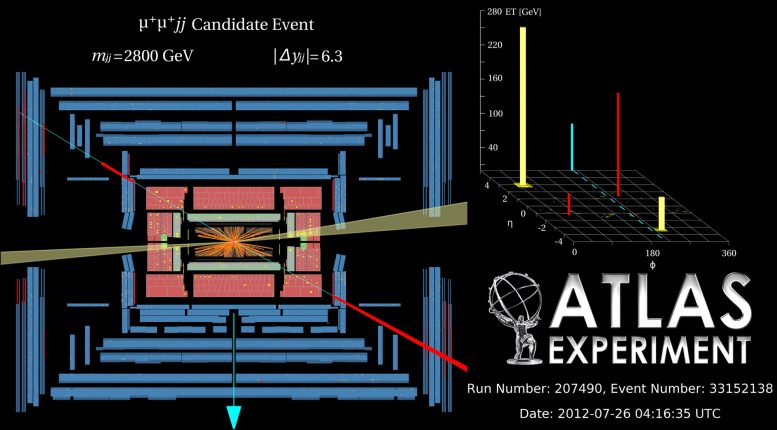
Candidate event for WW → WW scattering in the ATLAS detector at the Large Hadron Collider. Credit: Brookhaven National Laboratory
A new published study from the ATLAS Collaboration reports the first evidence of a process that can be used to test the mechanism by which the recently discovered Higgs particle imparts mass to other fundamental particles.
Scientists running the ATLAS experiment at the Large Hadron Collider (LHC), the world’s largest and most powerful “atom smasher,” report the first evidence of a process that can be used to test the mechanism by which the recently discovered Higgs particle imparts mass to other fundamental particles. More rare than the production of the Higgs itself, this process—a scattering of two same-charged particles called W bosons off one another—also provides a new stringent test of the Standard Model of particle physics. The findings, which so far are in agreement with predictions of the Standard Model, are reported in a paper just accepted by Physical Review Letters.
“Only about one in 100 trillion proton-proton collisions would produce one of these events,” said Marc-André Pleier, a physicist at the U.S. Department of Energy’s Brookhaven National Laboratory who played a leadership role in the analysis of this result for the ATLAS collaboration. Complicating matters further, finding one such rare event is not enough. “You need to observe many to see if the production rate is above or on par with predictions,” Pleier said. “We looked through billions of proton-proton collisions produced at the LHC for a signature of these events—decay products that allow us to infer like Sherlock Holmes what happened in the event.”
The analysis efforts started two years ago and were carried out in particular by groups from Brookhaven, Lawrence Berkeley National Laboratory, University of Michigan, and Technische Universität Dresden, Germany. Preliminary results were presented by Pleier at the “Rencontres de Moriond – QCD and High Energy Interactions” conference in March 2014. Now finalized based on a total of 34 observed events, the measured interaction rate is in good agreement with that predicted by the Standard Model, a theory describing all known fundamental particles and their interactions.
“The Standard Model has so far survived all tests, but we know that it is incomplete because there are observations of dark matter, dark energy, and the antimatter/matter asymmetry in the universe that can’t be explained by the Standard Model,” Pleier said. So physicists are always looking for new ways to test the theory, to find where and how it might break down.
“This process of W boson interactions is one we could never test,” Pleier said, “because we didn’t have enough energy or large enough data sets needed to see this very rare process—until we built the LHC.”
Now with the LHC data in hand, the measured rate agrees with the prevailing theory’s predictions and establishes a signal at a significance level of 3.6 sigma—strong evidence, according to Pleier. “The probability for this measurement to be a mere background fluctuation is very small—about one in 6000,” he said. But the physicists would like to be more certain by collecting more data to reduce uncertainties and increase the level of significance.
There’s another reason for continuing the quest: “By measuring this process we can check whether the Higgs particle we discovered does its job the way we expect it to,” Pleier said. “A wealth of models in addition to the Higgs mechanism exists to try to explain how fundamental particles get their mass. Measurements of such scattering processes can thus be both a fundamental test of the Standard Model and a window to new physics.”
To test the Higgs mechanism, the scientists compare distributions of decay products of the W scattering process—how often they observe particular products at a particular energy and geometrical configuration.
“It’s like a fingerprint,” Pleier said.“We have a predicted fingerprint and we have the fingerprint we measure. If the fingerprints match, we know that the Higgs does its job of mass generation the way it should. But if it deviates, we know that some other physics mechanism is helping out because the Higgs alone is not doing what we expect.”
Again, so far, the data indicate that the Higgs is working as expected.
“For the first time, we can rule out certain models or predictions that we could not before,” Pleier said. “To complete the job, we need more data, at higher energy, so we can see the fingerprint more clearly.”
The LHC will resume data taking at increased collision energies—13 tera-electronvolts (TeV) instead of 8 TeV—in spring of 2015. The datasets collected will be up to 150 times the size of the currently available data and will allow for a detailed behind-the-scenes look at the Higgs at work.
Reference: “Search for dark matter in events with a Z boson and missing transverse momentum in pp collisions at s√=8 TeV with the ATLAS detector” by G. Aad et al. (ATLAS Collaboration), 10 July 2014, Physical Review Letters.
DOI: 10.1103/PhysRevD.90.012004
The ATLAS experiment at LHC is supported by DOE’s Office of Science and the National Science Foundation.
Brookhaven National Laboratory serves as the U.S. host laboratory for the ATLAS experiment at the LHC, and plays multiple roles in this international collaboration, from construction and project management to data storage, distribution, and analysis, funded by the DOE Office of Science (HEP).
DOE’s Office of Science is the single largest supporter of basic research in the physical sciences in the United States, and is working to address some of the most pressing challenges of our time.

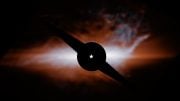
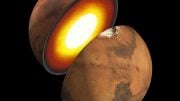
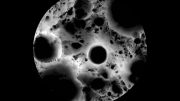
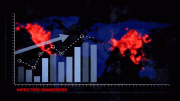
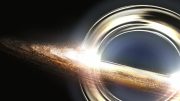

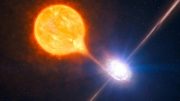
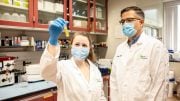
It seems that Higgs Boson happens to be the precursor for much available W+, W- and Z Bosons, which we find in nature. We have been experimenting Boson-Lepton interaction (As in the case of Raman Effect, Production of X-rays, Compton Effect, Zeeman Effect etc) and also lepton-lepton reaction in Particle accelerators to produce exotic particles. But Boson-Boson reaction has been rarely studied. It has been observed in cosmic rays, a highly energetic Gamma ray photon, yielding leptons like electrons and positrons in pairs, where the experiment is purely a cosmic phenomena. A Boson – Boson reaction yielding massive leptons is an interesting phenomena. This experiment of charged Bosons like W+ particles to collide with each other to yield some interesting massive particles ,instead of only lepton-lepton collision hitherto undertaken as in the case of two protons colliding at tremendous energy, is interesting.It all goes to show that existence of Higgs Boson is validated. A small transformation of Higgs Boson only is the W+,W- and Z Bosons which we find abundantly in nature. Here it is in an intermediate stage and hence they get detected. However, much of the Higgs Bosons, had already imparted mass to electrons and other fundamental particles, where the transformation is complete and hence it goes undetected. Still the warehouse of Higgs Bosons exist in nature, for the ultimate matter formation. They could exist in undisturbed and undetected form in Dark Matter also. Higgs associated with neutral particle like neutrinos (which are massless to a great extent, and yet has got an infinitesimally small mass) and even the neutral Z Boson is interesting.Can we say that Higgs is the ultimate creator of the Universe and yet cannot be isolated ? Still we don’t know the anatomy of Higgs. Thank You.